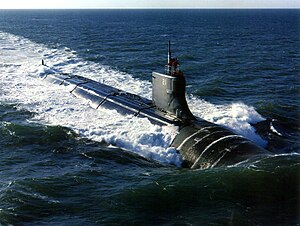| Seawolf-class submarine | |
|---|---|
 The USS Seawolf (SSN-21) underway. | |
| Class overview | |
| Builders: | General Dynamics Electric Boat |
| Operators: |
|
| Preceded by: | Los Angeles-class submarine |
| Succeeded by: | Virginia-class submarine |
| Built: | 1989–2005 |
| In commission: | 1997–present |
| Planned: | 29 |
| Completed: | 3 |
| Cancelled: | 26 |
| Active: | 3 |
| General characteristics | |
| Displacement: |
Surfaced: 8,600 tons Submerged: 9,138 tons[1] |
| Length: | 353 ft (107 m) |
| Beam: | 40 ft (12 m) |
| Propulsion: |
1 S6W PWR 45,000 hp 1 secondary propulsion submerged motor 1 shaft 1 propeller |
| Speed: |
Surfaced: 18 knots (21 mph; 33 km/h) Submerged: 35 knots (40 mph; 65 km/h) |
| Range: | unlimited |
| Endurance: | unlimited except by food supplies |
| Test depth: | 2,000 ft (610 m)[2] |
| Complement: | 140 |
| Crew: | 14 officers; 126 enlisted |
| Armament: | 8 × 660mm torpedo tubes (50 Tomahawk cruise missile/Harpoon/Mk-48 torpedo) |
The Seawolf-class is a class of nuclear-powered fast attack submarines (SSN) in service with the United States Navy. The class was the intended successor to the Los Angeles class. Design work began in 1983.[3] At one time, an intended fleet of 29 submarines was to be built over a ten-year period, later reduced to twelve submarines. The end of the Cold War and budget constraints led to the cancellation in 1995 of any further additions to the fleet, leaving the Seawolf class limited to just three boats. This, in turn, led to the design of the smaller Virginia class.
Design[]
The Seawolf design was intended to combat the threat of large numbers of advanced Soviet ballistic missile submarines such as the Typhoon class and attack submarines such as the Akula class in a deep ocean environment. Seawolf class hulls are constructed from HY-100 steel, which is stronger than the HY-80 steel employed in previous classes, in order to withstand water pressure at greater depths.[4][5] The exact diving depth of this class of boats is classified; most reputable sources[Who?] vary from 1,600–2,000 feet as a likely test depth, and from 2,400–3,200 feet for collapse depth. These figures are consistent with their original design parameters and not unlikely.[according to whom?]
Compared to previous Los Angeles class submarines, Seawolf submarines are larger, faster, and significantly quieter; they also carry more weapons and have twice as many torpedo tubes, for a total of 8. The boats are able to carry up to 50 UGM-109 Tomahawk cruise missiles for attacking land and sea surface targets. As in all nuclear submarines, the load out of equipment, weapons and crew affects available excess buoyancy and thus operational parameters. The boats also have extensive equipment to allow for littoral, or shallow water, operations. The class uses the more advanced ARCI Modified AN/BSY-2 combat system, which includes a new, larger spherical sonar array, a wide aperture array (WAA), and a new towed-array sonar.[6] Each boat is powered by a single S6W nuclear reactor, delivering 45,000 hp to a low-noise pump-jet.
As a result of their advanced design, however, Seawolf submarines were much more expensive. The projected cost for twelve submarines of this class was $33.6 billion, but after the Cold War, construction was stopped at three boats.[7]
Variants[]
The USS Jimmy Carter is roughly 100 feet (30 m) longer than the other two boats of her class due to the insertion of a section known as the Multi-Mission Platform (MMP), which allows launch and recovery of ROVs and Navy SEAL forces.[8] The MMP may also be used as an underwater splicing chamber for tapping of undersea fiber optic cables. This role was formerly filled by the decommissioned USS Parche (SSN-683). Jimmy Carter was modified for this role by Electric Boat at the cost of $887 million.[9]
Boats[]
- USS Seawolf (SSN-21) – commissioned and in service
- USS Connecticut (SSN-22) – commissioned and in service
- USS Jimmy Carter (SSN-23) – commissioned and in service
See also[]
- Virginia class submarine
- Los Angeles class submarine
- List of submarine classes of the United States Navy
- Submarines in the United States Navy
- List of submarines of the United States Navy
References[]
| Wikimedia Commons has media related to Seawolf class submarines. |
- ↑ "The US Navy – Fact File". US Navy. http://www.navy.mil/navydata/fact_display.asp?cid=4100&tid=100&ct=4. Retrieved 2008-08-30.
- ↑ "SSN Seawolf Class Attack Submarine". Naval-technology.com. http://www.naval-technology.com/projects/seawolf/. Retrieved 2008-08-30.
- ↑ http://www.navy.mil/navydata/cno/n87/history/chrono.html
- ↑ Polmar, Norman (2004). The Naval Institute guide to the ships and aircraft of the U.S. fleet (18 ed.). Annapolis, Maryland: Naval Institute Press. pp. 81–82. ISBN 978-1-59114-685-8. http://books.google.com/books?id=8MwyTX-iA2wC&pg=PA81. Retrieved 2011-07-01.
- ↑ Zimmerman, Stan (2000). Submarine Technology for the 21st Century. Victoria, British Columbia: Trafford Publishing. p. 81. ISBN 978-1-55212-330-0. http://books.google.com/books?id=SjfgOfV8Am0C&pg=PA81. Retrieved 2011-07-01.
- ↑ http://www.harpoondatabases.com/Encyclopedia/Entry2316.aspx
- ↑ "SSN-21 Seawolf Class". Federation of American Scientists. http://www.fas.org/programs/ssp/man/uswpns/navy/submarines/ssn21_seawolf.html. Retrieved 2011-08-11.
- ↑ "USS Jimmy Carter (SSN-23)". Submarinehistory.com. http://www.submarinehistory.com/JimmyCarter.html. Retrieved 2009-06-10.
- ↑ "Seawolf Class". General Dynamics Electric Boat. http://www.gdeb.com/about/product/seawolf/. Retrieved 2011-08-05.
| |||||||||||
| ||||||||||||||||||||||||||
| ||||||||||||||||||||
The original article can be found at Seawolf-class submarine and the edit history here.